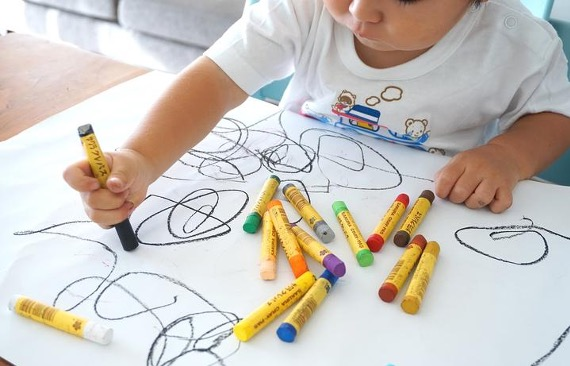by Cindy Johanson, Douglas County Libraries
Guest Blogger

From birth to age five, children take a remarkable journey. As they babble new words and wobble toward outstretched arms, they also make strides toward literacy. Four of the five early literacy practices – singing, playing, reading, and talking – seem to come naturally when interacting with kids. However, it takes a more concerted effort to practice writing with preschoolers. In these critical early years, educators and caregivers have the chance to capture kids’ interest and enthusiasm, fostering a love of writing.
For emerging writers, the journey from primitive scribbles to polished handwriting is a years-long trek filled with excitement and frustration, achievements and detours. Before children can actually write and read, they advance through stages of readiness – from pre-literate to emergent to transitional to fluent (see the chart at https://www.whps.org/uploaded/Offices/Curriculum_Instruction_and_Assessment/Families_-_Academics/Stages_of_Writing_Development.pdf) for examples of the developmental writing stages.
Common writing milestones include scribbling, drawing shapes and figures, experimenting with letters, recognizing word concepts and spacing, and writing using normal conventions.
Although each child progresses at his own pace, writing readiness must start well before kindergarten, researchers agree. When writing skills are introduced early, educators can identify conditions such as dysgraphia and provide extra assistance with handwriting, spelling, and fine motor skills. On the other hand, children who struggle without help may become discouraged or fall behind as they are asked to complete more challenging assignments.
To make writing more enticing from the start, educators can team up with librarians, childcare providers and parents to support future scribes. Check out the following sections for ideas on how to encourage fledgling writers.

Early literacy advocates can promote pre-writing skills in storytime:
- Choose fingerplays that develop large and fine motor skills.
- Plan movements in which participants cross the midline of their bodies, linking the left and right sides of the brain.
- Model actions that increase hand-eye coordination.
- Promote fitness to develop upper body strength and good posture.
- Teach vocabulary words such as up, down, and around that are used in writing letters of the alphabet.
At home and in daycare, hands-on activities help kids to develop skills:
- Draw and scribble with thick markers, crayons, and paper.
- Roll playdough into shapes and letters, building hand strength that will help with later handwriting control.
- Paint with Q-tips or paintbrushes using water or water-based colors.
- Finger paint in pudding, shaving cream, rice or flour.
Parents can also promote awareness of writing in day-to-day activities:
- Post a family message board and leave notes to each other.
- Have kids dictate a grocery list and go shopping together.
- Ask your child to draw pictures and compose a story.
- Use glow sticks to form simple words or a child’s name.
- Display letter or word magnets on the refrigerator.
- Point out words while reading books together.
(For a list of books that encourage writing, see the following CLEL recommendations at https://www.clel.org/silver-bells-write and the annual winners at https://www.clel.org/bell-awards-winners.)
Children will express varying degrees of interest in early writing. Ultimately, allow kids to take the lead in their writing exploration, giving them chances to have fun by piquing their interest and letting them pave the way.
Sources:
- https://elearninginfographics.com/developing-pre-writing-skills-early-childhood-infographic/
- http://www.lizs-early-learning-spot.com/pre-writing-skills-essential-for-early-learners/
- https://www.noodle.com/articles/reading-and-writing-milestones-how-and-when-children-develop
- https://www.readingrockets.org/article/how-writing-develops
- https://verywellfamily.com/teaching-children-to-write-4148450
- https://www.whps.org/uploaded/Offices/Curriculum_Instruction_and_Assessment/Families_-_Academics/Stages_of_Writing_Development.pdf
Please note that as a guest post, the views expressed here do not represent the official position or opinion of the Colorado Libraries for Early Literacy organization or the individual committee members.
